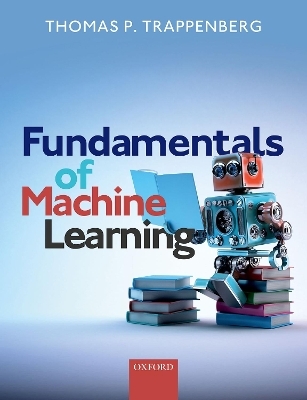
Fundamentals of Machine Learning
Oxford University Press (Verlag)
978-0-19-882804-4 (ISBN)
Interest in machine learning is exploding worldwide, both in research and for industrial applications. Machine learning is fast becoming a fundamental part of everyday life.
This book is a brief introduction to this area - exploring its importance in a range of many disciplines, from science to engineering, and even its broader impact on our society. The book is written in a style that strikes a balance between brevity of explanation, rigorous mathematical argument, and outlines principle ideas. At the same time, it provides a comprehensive overview of a variety of methods and their application within this field. This includes an introduction to Bayesian approaches to modeling, as well as deep learning.
Writing small programs to apply machine learning techniques is made easy by high level programming systems, and this book shows examples in Python with the machine learning libraries 'sklearn' and 'Keras'. The first four chapters concentrate on the practical side of applying machine learning techniques. The following four chapters discuss more fundamental concepts that includes their formulation in a probabilistic context. This is followed by two more chapters on advanced models, that of recurrent neural networks and that of reinforcement learning. The book closes with a brief discussion on the impact of machine learning and AI on our society.
Fundamentals of Machine Learning provides a brief and accessible introduction to this rapidly growing field, one that will appeal to students and researchers across computer science and computational neuroscience, as well as the broader cognitive sciences.
Dr. Trappenberg is a professor of Computer Science at Dalhousie University. He holds a PhD in physics from RWTH Aachen University and held research positions in Canada, Riken Japan, and Oxford England. His main research areas are computational neuroscience, machine learning and robotics. He is the author of Fundamental of Computational Neuroscience and the cofounder of Nexus Robotics and ReelData. He is currently working on applying AI to several other areas in the food industry and in medical applications.
1. Introduction
1.1: The basic idea and history of Machine Learning
1.2: Mathematical formulation of the basic learning problem
1.3: Nonlinear regression in highdimensions
1.4: Recent advancements
1.5: No free lunch
I A PRACTICAL GUIDE TO MACHINE LEARNING
2. Scientific programming with Python
2.1: Programming environment
2.2: Basic language elements
2.3: Code efficiency and vectorization
2.4: Data handling
2.5: Image processing and convolutional filters
3. Machine learning with sklearn
3.1: Classification with SVC, RFC and MLP
3.2: Performance measures and evaluations
3.3: Data handling
3.4: Dimensionality reduction, feature selection, and tSN
3.5: Decision Trees and Random Forests *
3.6: Support Vector Machines (SVM) *
4. Neural Networks and Keras
4.1: Neurons and the threshold perceptron
4.2: Multilayer Perceptron (MLP) and Keras
4.3: Representational learning
4.4: Convolutional Neural Networks (CNNs)
4.5: What and Where
4.6: More tricks of the trade
II FOUNDATIONS: REGRESSION AND PROBABILISTIC MODELING
5. Regression and optimization
5.1: Linear regression and gradient descent
5.2: Error surface and challenges for gradient descent
5.3: Advanced gradient optimization (learning)
5.4: Regularization: Ridge regression and LASSO
5.5: Nonlinear regression
5.6: Backpropagation
5.7: Automatic differentiation
6. Basic probability theory
6.1: Random numbers and their probability (density) function
6.2: Moments: mean, variance, etc.
6.3: Examples of probability (density) functions
6.4: Some advanced concepts
6.5: Density functions of multiple random variables
6.6: How to combine prior knowledge with new evidence
7. Probabilistic regression and Bayes nets
7.1: Probabilistic models
7.2: Learning in probabilistic models: Maximum likelihood estimate
7.3: Probabilistic classification
7.4: MAP and Regularization with priors
7.5: Bayes Nets: Multivariate causal modeling
7.6: Probabilistic and Stochastic Neural Networks
8. Generative Models
8.1: Modelling classes
8.2: Supervised generative models
8.3: Naive Bayes
8.4: Unsupervised generative models
8.5: Generative Neural Networks
III ADVANCED LEARNING MODELS
9. Cyclic Models and Recurrent Neural Networks
9.1: Sequence processing
9.2: Simple Sequence MLP and RNN in Keras
9.3: Gated RNN and attention
9.4: Models with symmetric lateral connections
10. Reinforcement Learning
10.1: Formalization of the problem setting
10.2: Modelbased Reinforcement Learning
10.3: Modelfree Reinforcement Learning
10.4: Deep Reinforcement Learning
10.5: Actors and actorcritics
11. AI, the brain, and our society
11.1: Different levels of modeling and the brain
11.2: Machine learning and AI
11.3: The impact machine learning technology on society
| Erscheinungsdatum | 03.01.2020 |
|---|---|
| Verlagsort | Oxford |
| Sprache | englisch |
| Maße | 189 x 245 mm |
| Gewicht | 568 g |
| Themenwelt | Informatik ► Theorie / Studium ► Künstliche Intelligenz / Robotik |
| Naturwissenschaften ► Biologie ► Humanbiologie | |
| Naturwissenschaften ► Biologie ► Zoologie | |
| ISBN-10 | 0-19-882804-7 / 0198828047 |
| ISBN-13 | 978-0-19-882804-4 / 9780198828044 |
| Zustand | Neuware |
| Informationen gemäß Produktsicherheitsverordnung (GPSR) | |
| Haben Sie eine Frage zum Produkt? |
aus dem Bereich


